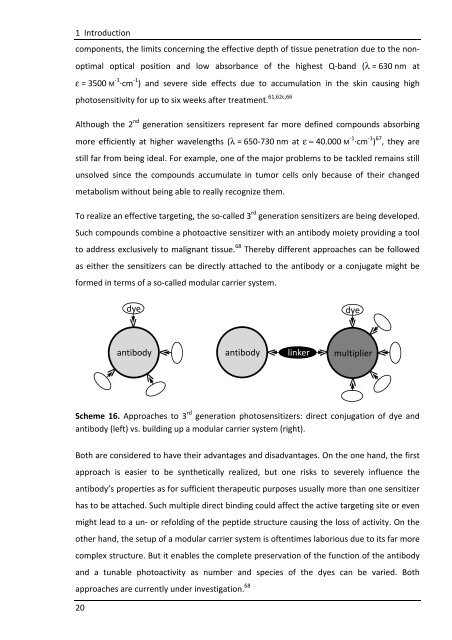1.1 Porphyrins - Friedrich-Alexander-Universität Erlangen-Nürnberg
1.1 Porphyrins - Friedrich-Alexander-Universität Erlangen-Nürnberg
1.1 Porphyrins - Friedrich-Alexander-Universität Erlangen-Nürnberg
Create successful ePaper yourself
Turn your PDF publications into a flip-book with our unique Google optimized e-Paper software.
1 Introduction<br />
components, the limits concerning the effective depth of tissue penetration due to the non-<br />
optimal optical position and low absorbance of the highest Q-band (λ = 630 nm at<br />
ε = 3500 M -1 ·cm -1 ) and severe side effects due to accumulation in the skin causing high<br />
photosensitivity for up to six weeks after treatment. 61,62c,66<br />
Although the 2 nd generation sensitizers represent far more defined compounds absorbing<br />
more efficiently at higher wavelengths (λ = 650-730 nm at ε ≈ 40.000 M -1 ·cm -1 ) 67 , they are<br />
still far from being ideal. For example, one of the major problems to be tackled remains still<br />
unsolved since the compounds accumulate in tumor cells only because of their changed<br />
metabolism without being able to really recognize them.<br />
To realize an effective targeting, the so-called 3 rd generation sensitizers are being developed.<br />
Such compounds combine a photoactive sensitizer with an antibody moiety providing a tool<br />
to address exclusively to malignant tissue. 68 Thereby different approaches can be followed<br />
as either the sensitizers can be directly attached to the antibody or a conjugate might be<br />
formed in terms of a so-called modular carrier system.<br />
20<br />
dye<br />
antibody<br />
antibody<br />
linker<br />
dye<br />
multiplier<br />
Scheme 16. Approaches to 3 rd generation photosensitizers: direct conjugation of dye and<br />
antibody (left) vs. building up a modular carrier system (right).<br />
Both are considered to have their advantages and disadvantages. On the one hand, the first<br />
approach is easier to be synthetically realized, but one risks to severely influence the<br />
antibody’s properties as for sufficient therapeutic purposes usually more than one sensitizer<br />
has to be attached. Such multiple direct binding could affect the active targeting site or even<br />
might lead to a un- or refolding of the peptide structure causing the loss of activity. On the<br />
other hand, the setup of a modular carrier system is oftentimes laborious due to its far more<br />
complex structure. But it enables the complete preservation of the function of the antibody<br />
and a tunable photoactivity as number and species of the dyes can be varied. Both<br />
approaches are currently under investigation. 68

















